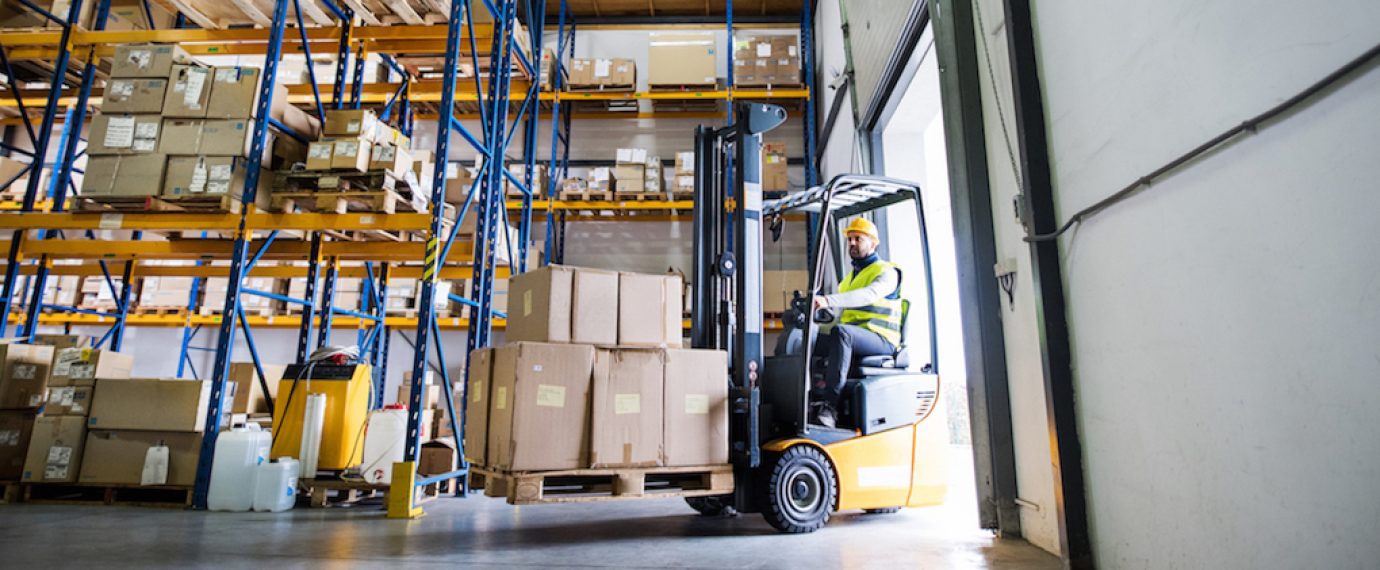Forklifts and other powered industrial trucks frequently operate in the same areas as pedestrians and workers. Far too often, close calls or near misses occur when both forklift operators and pedestrians become complacent in their surroundings. This contributes to over 100 fatalities and 90,000 injuries annually in the workplace. Over 20 percent of forklift accidents involve employees or pedestrians being hit by forklifts, making it the number two cause of forklift-related accidents and injuries (just behind forklifts tipping or rolling over after becoming unstable from exceeding the load capacity of the truck).
Remember, when a forklift and pedestrian collide, the forklift will always win. Consider the following options to minimize the risk of a serious or fatal injury when a pedestrian and forklift collide.
Engineering and Physical Facility Controls
- Designated Walkways and Floor Markings: Outside of work cells, pedestrian aisles should be clearly marked to designate where foot traffic is permitted and where powered trucks travel. While painting yellow floor lines is most common and sometimes adequate, segregating the walkway with barricades, stanchions, or similar physical barriers is a best practice, especially in congested or busy areas. Additional markings or stop signs can be placed at intersections and blind areas to visually remind people to slow down, stop, and look before proceeding. Strictly enforce walkways once they are established.
- No Forklift and/or No Pedestrian Zones: Do pedestrians really need to walk through that area? Many facilities restrict pedestrian access in loading docks and warehouse racking areas or conversely in work cells for powered trucks. Designate and enforce a separated pedestrian walkway or forklift travel-way around these areas if possible. Require a second “spotter” if powered trucks need to operate in pedestrian-only zones (think of the employees with flags guiding trucks around Home Depot).
- Blue Lights: It may seem simple, but installing blue spotlights on forklifts that shine a bright blue spot onto the floor 15 feet in front of a forklift’s direction of travel can effectively alert others that a forklift is approaching, even if they cannot physically see the forklift yet. This is especially effective at intersections, corners, and blind spots. Lights are relatively inexpensive and additional options are available that shine red light on the floor to the sides of forklifts serving as additional visual reminders to stay away from the sides (and wheels) of trucks.
- Sentry Systems: Install Collision Sentry warning systems where forklift traffic and pedestrians intersect. These systems monitor movement in multiple directions and flash a visual warning (strobe or similar) and/or emit an audible sound to warn pedestrians and forklift operators of approaching traffic. A variety of models are available and are relatively inexpensive. Using them in combination with convex mirrors is particularly effective.
Administrative Controls
- Forklift Pedestrian Safety Awareness Training: Train all of your employees on the dangers of forklift collisions, how to avoid them (see Rules below), the facility control measures in place, and expectations of the use of designated walkways or other control measures. Enforce adherence to the established control measures.
- Operator Training Inclusive of Facility-Specific Hazards: All forklift and powered industrial truck operators are required to have classroom training, initial hands-on training, and a performance evaluation (certification with recertification every three years) for each type of equipment they are certified to operate. This training should include information on hazards that are specific to the facility, such as hazardous environments (i.e. presence of flammable vapors and restricted areas) and hazardous activities (i.e. operation in highly congested areas, blind spots, use of truck docks and pallet racking, traveling outside, etc.) and how to properly operate in the identified conditions. Discussion on pedestrian safety should be included in this training (see Rules below).
General Forklift and Pedestrian Rules
- Pedestrians technically have the right-of-way but remember it is a two-way street. Both the pedestrian and the operator need to be aware of their surroundings.
- Intentionally slow down and physically stop at intersections and blind spots. Look in all directions before proceeding.
- Never step out in front of equipment.
- Never walk over or under forks.
- Stay an arm’s distance away when approaching equipment.
- Make eye contact (between the pedestrian and forklift operator), communicate and understand each other’s intentions (where each other is going), pause and wait for the other person to clear the area before proceeding.
Forklift Operator Rules
- Use your horn and slow down when entering doorways, passageways, approaching blind spots or intersections, or traveling near pedestrian congregation areas.
- Never leave equipment powered on and unattended (lower forks to the ground, neutralize controls, apply the parking brake, and turn off the equipment if you are out of sight or more than 25 feet away).
- Always look in the direction of travel. If a load is blocking your view forward, drive in reverse.
- Never exceed the rated capacity of the truck you are operating.
- Never allow pedestrians to position themselves between a forklift and a permanent object.
- Never lift people with equipment, unless using an approved and secured lifting cage.
- Never carry passengers.



